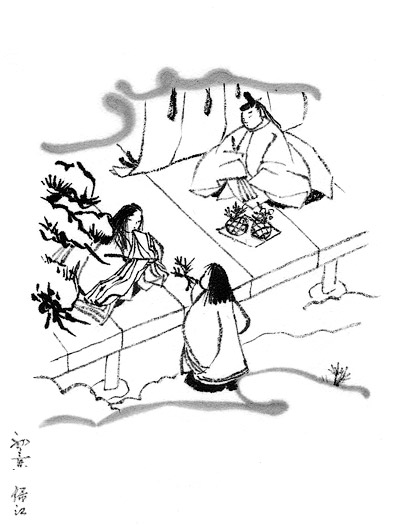|
||
 |
||

@
(C)2001 Japanese Architecture and Art Net Users System.@No reproduction or republication without written permission.
fΪΜeLXgEΚ^ECXgΘΗASΔΜRecΜ³f‘»E]ΪπΦΆά·B
|
||||||
| @ | ||||||
| Hatsune@Ή | ||||||
| KEY WORD :@art history / paintings | ||||||
| @ | ||||||
| A pictorial subject taken from "The First Warbler"
or more literally "The First Song", Chapter 23 of GENJI MONOGATARI Ή¨κ
(The Tale of Genji). This very short chapter centers around an exchange of New
Year's greetings between Genji and the ladies of the Rokujou Zπ Mansion (see *Otome
³): Lady Murasaki (see *Wakamurasaki α), the Akashi Lady (see *Akashi ΎΞ,
*Matsukaze Ό), the Lady of the Orange Blossoms *Hanachirusato
ΤU’, *Tamakazura Κι‘, the Safflower
Lady *Suetsumuhana EΤ,
and the Lady of the Locust Shell *Utsusemi
σδ. A frequently illustrated scene shows Genji receiving New Year delicacies
in bearded baskets, higeko EβΔ (baskets with the ends of the woven strands
left untrimmed) and a warbler uguisu § on an artificial pine branch,
sent over by the princess's mother, the Akashi Lady . Attached to the branch is
a letter with a poem telling of her loneliness. Hatsune motifs on craft objects
were popular because of their auspicious, new-beginning symbolism. The elaborate
lacquered furnishings of Tokugawa Chiyohime's ΏμηγP trousseau, called Hatsune
no choudo ΉΜ²x (1639; Tokugawa Ώμ Museum) are well-known for their decoration.
|
||||||
| @ | ||||||
 |
||||||
@ |
||||||
| REFERENCES: | ||||||
| *genji-e ΉG | ||||||
| EXTERNAL LINKS: | ||||||
| @@ | ||||||
| NOTES: | ||||||
| @ | ||||||
(C)2001 Japanese Architecture and Art Net Users System.@No reproduction or republication without written permission. fΪΜeLXgEΚ^ECXgΘΗASΔΜRecΜ³f‘»E]ΪπΦΆά·B |
||||||
| @ |